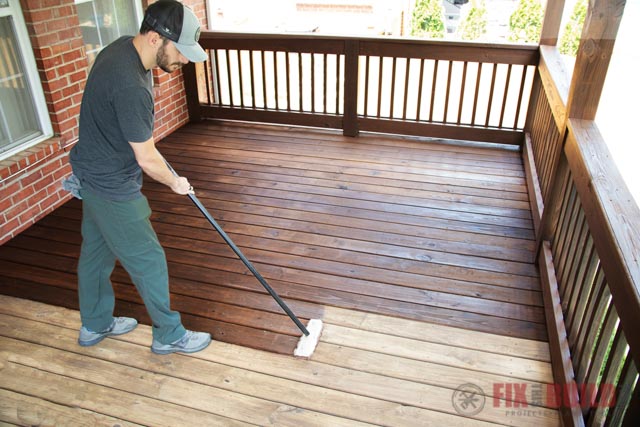Deck Staining Wonders: Transforming Your Exterior Sanctuary
Deck Staining Wonders: Transforming Your Exterior Sanctuary
Blog Article
Selecting the Right Discoloration for Your Fencing: Tips and Considerations
When it involves preserving and boosting the appearance of your fencing, picking the best tarnish is vital. With a wide selection of alternatives available, it can be overwhelming to figure out which tarnish will certainly finest suit your needs. This overview will give you with suggestions and factors to consider to aid you make a notified choice. We will certainly discover the different kinds of fencing discolorations, variables to consider before choosing a discolor, tips for preparing your fence for discoloration, and the distinctions between oil-based and water-based spots. Furthermore, we will explore selecting the appropriate discolor shade to match your fencing and enhance your outdoor area. By following these guidelines, you can guarantee that your fence remains safeguarded and aesthetically pleasing for years ahead.
Recognizing Different Sorts Of Fence Discolorations

On the various other hand, water-based spots are made from acrylic or latex and use a much more subtle color to the timber. They produce a safety film on the surface of the wood, protecting against dampness from permeating in and safeguarding against UV damages. Water-based spots are easier to tidy up and have a much faster drying out time compared to oil-based stains. They are also much less likely to fracture or fade with time.
Picking between water-based and oil-based stains depends upon different aspects, including personal preference, the desired look, and the degree of upkeep required. Oil-based spots are recommended for fences in high-traffic areas or those regularly revealed to severe climate condition. deck staining. Water-based spots, on the various other hand, are a preferred option for fencings in houses where look and ease of use are necessary
When picking the best discolor for their fencing,Recognizing the distinctions in between water-based and oil-based spots aids homeowners make an informed decision. Considering the specific demands of the fencing, such as its location, exposure to sunlight, and preferred visual, will certainly make sure that the picked tarnish supplies resilient security and boosts the general beauty of the fencing.
Elements to Take Into Consideration Prior To Choosing a Spot

Different kinds of timber absorb spots in different ways, resulting in varying levels of color strength and resilience. Furthermore, certain woods might be more susceptible to concerns like rot or insect invasion, which might impact the choice of discolor to protect the fence and protect.
The environment and climate condition in your area need to additionally be taken right into account. If you stay in a location with extreme winters or high humidity, you might require a discolor that offers extra defense versus moisture and UV rays. If your fencing is subjected to route sunshine for lengthy periods, a stain with UV inhibitors can aid stop fading and discoloration.
Last but not least, it is very important to consider your desired aesthetic. Various discolorations supply numerous colors and finishes, allowing you to tailor the appearance of your fencing (deck staining). Consider the total style and design of your building, in addition to any neighborhood laws or house owner association standards that might determine the acceptable tarnish colors
Tips for Readying Your Fence for Discoloration
Cleansing the fence is a vital step as it gets rid of dirt, gunk, and any kind of previous finishings that might conflict with the discoloration process. Rub the surface area carefully, paying additional attention to areas with persistent stains or mold.
This step is vital as tarnishing a wet or moist surface can lead to bad bond and an irregular finish. Guarantee that the fence is totally dry before proceeding with the staining process.
Before staining, evaluate the fencing for any type of damages, such as loosened boards or nails. This product helps to open up the timber pores, enabling the stain to pass through a lot more successfully and uniformly.

Comparing Water-Based and oil-based Stains
When choosing a tarnish for your fence, it is necessary to contrast the attributes and advantages of water-based and oil-based discolorations. Both kinds of stains have their own benefits and considerations, so it is important to recognize the differences between them.
Oil-based discolorations are recognized for their durability and resistance to wear and tear. Additionally, oil-based stains often tend to last longer than water-based stains, making them a popular choice for fences.
On the other hand, water-based stains are more environmentally pleasant and much websites easier to clean up. They may not offer the exact same degree of security as oil-based spots, especially in harsh weather conditions.
Ultimately, the option between oil-based and water-based discolorations relies on your particular needs and choices. Think about factors such as toughness, ecological effect, and ease of application when making your decision. Consulting with a specialist or seeking recommendations from specialists can additionally aid ensure that you choose the ideal stain for your fence.
Choosing the Right Spot Shade for Your Fencing
The option of an appropriate discolor color for your fence is an important facet of improving its visual charm and matching the overall design of your outside room (fence staining and sealing). The right stain color can transform a level, normal fence right into a striking prime focus that includes depth and personality to your home
When picking a stain color for your fence, it is very important to take into consideration the style and design of your home. If you have a standard or timeless style home, earthy tones such as browns and neutrals can develop a warm and inviting appearance. On the various other hand, if you have a modern or modern home, you might take into consideration choosing strong and dynamic shades that make a declaration.
Another element to think about is the all-natural environments of your property. If you have a great deal of plant, a tarnish color that enhances the natural landscape, such as environment-friendlies or crimsons, can develop a harmonious and cohesive look.
Additionally, it's worth taking into consideration the maintenance needed for various discolor shades. Lighter shades often tend to reveal dirt and wear more easily, while darker colors can hide imperfections and need much less frequent touch-ups.
Eventually, the option of discolor color for your fence ought to show your individual style and preferences - deck staining companies near me. Make the effort to explore different alternatives and consult with experts if required, to make certain that you pick the best tarnish shade that boosts the elegance and allure of your fencing
Verdict
Finally, when it involves selecting the ideal discolor for your fence, it is necessary to recognize the various sorts of discolorations available and take into consideration aspects such as toughness and preferred appearance. Preparing the fence appropriately before staining is important for achieving optimum results. Furthermore, contrasting water-based and oil-based stains can help identify the most effective choice for your certain demands. Choosing the appropriate stain shade can enhance the overall aesthetics of your fencing.
We will explore the various kinds of fencing spots, variables to think about before picking a stain, ideas for preparing your fencing for discoloration, and the differences between water-based and oil-based discolorations.Distinguishing between water-based and oil-based spots is critical when comprehending various kinds of fence discolorations. Water-based spots are simpler to cleanse up and have a quicker drying time compared to oil-based discolorations. In addition, oil-based spots tend to last longer than water-based stains, making them a popular choice for fences.
In conclusion, when it comes to selecting the ideal discolor for your fencing, it is crucial to comprehend the various kinds of discolorations available and consider aspects such as durability and desired look.
Report this page